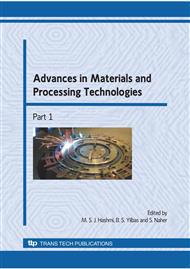p.1243
p.1251
p.1254
p.1262
p.1270
p.1282
p.1288
p.1297
p.1306
Elevated Temperature Wear of Submicron Al2O3 Reinforced 6061 Aluminum Composite
Abstract:
The effects of load and temperature on wear behavior of 6061 Aluminum alloy matrix composite reinforced with 20% Al2O3 (submicron) particulates against AISI 4041 steel disc were studied at elevated temperatures ranging from 25oC to 300oC. Mild and severe wear regions separated by a transition region were observed at all temperatures with a difference of two orders of magnitude between mild and severe wear. The critical loads observed at 100oC, 200oC and 300oC were 40 N (2 MPa), 30 N (1.53 MPa) and 15 N (0.76 MPa) respectively indicating that wear resistance of the composite decreases with increase in temperature. Scanning electron microscopy revealed that wear was accompanied by extensive thermal softening of the matrix, in addition to particulate fracture due to high shear strain generated from the contacts and material transfer to the counterface. The wear rates were reduced in the mild wear regime due to oxidation of the iron counterface and deposition of oxides on the contact surfaces evident by EDS analysis.
Info:
Periodical:
Pages:
1288-1296
Citation:
Online since:
December 2009
Authors:
Price:
Сopyright:
© 2010 Trans Tech Publications Ltd. All Rights Reserved
Share:
Citation:


